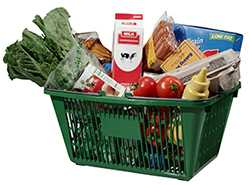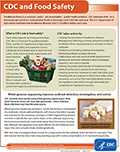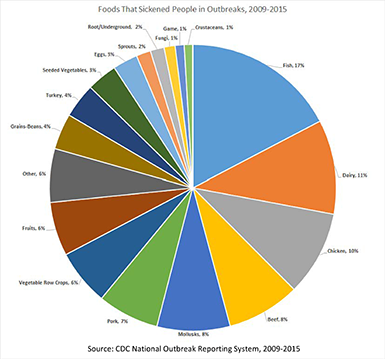CDC and Food Safety
Foodborne illness is a common, costly—yet preventable—public health problem. CDC estimates that 1 in 6 Americans get sick from contaminated foods or beverages and 3,000 die each year. The U.S. Department of Agriculture (USDA) estimates that foodborne illnesses cost $15.6 billion each year.
The future of food safety depends on:
- Supporting Centers of Excellence that are faster at responding to foodborne outbreaks
- Developing and sharing whole genome sequencing technology with all 50 state PulseNet laboratories
- Developing and improving ways to integrate and share surveillance data with partners and the public
- Working with other countries and international agencies to improve surveillance, investigation and prevention of foodborne infections around the world
What Is CDC’s Role in Food Safety?
Food safety depends on strong partnerships. CDC, the U.S. Food and Drug Administration (FDA), and USDA’s Food Safety and Inspection Service collaborate at the federal level to promote food safety. State and local health departments and food industries also play critical roles in all aspects of food safety.
CDC provides the vital link between illness in people and the food safety systems of government agencies and food producers.

CDC takes action by:
- Tracking the occurrence of foodborne illnesses
- Managing the DNA fingerprinting network (PulseNet) for foodborne illness-causing bacteria in all states to detect outbreaks
- Facilitating and leading outbreak investigations
- Monitoring antibiotic-resistant infections
- Collaborating with state and local health departments to develop new and better methods to detect, investigate, respond to, and control outbreaks
- Defining the public health burden of foodborne illness
- Attributing illnesses to specific foods and settings
- Targeting prevention measures to meet food safety goals
- Providing data and analyses to inform food safety action and policy, such as the FDA Food Safety Modernization Act regulations and USDA’s stronger Salmonella and Campylobacter standards for poultry
A Better Way to Find Outbreaks

Listeriosis linked to soft cheeses sickened 30 people and killed 3.
CDC scientists have started using whole genome sequencing to show which bacterial strains are most alike genetically—which indicates those infections may have the same source.
Whole genome sequencing provided a crucial clue during an investigation of a multistate Listeria outbreak linked to soft cheeses that killed three people and sickened 30. The traditional technique of DNA fingerprinting allowed scientists to identify five rare Listeria strains in the outbreak. Sequencing the bacteria provided even more detail about those five strains, showing that although they appeared to be quite different by the traditional technique, they were actually closely related genetically.
With that clue, investigators knew to look for a single source for the outbreak, which led them to one dairy. They later learned that the dairy had a long-standing issue with Listeria contamination in its manufacturing facility.
Challenges to America’s Food Safety
Changes in the Food Supply and New Sources of Illnesses
Sometimes foods we love to eat and rely on for good health are contaminated with bacteria that cause illness and can be deadly for certain people. More progress is needed to protect people and reduce foodborne illnesses in America.
Challenges to food safety will continue to arise in unpredictable ways, largely due to:
- Changes in our food production and supply, including more imported foods
- Changes in the environment leading to food contamination
- Finding more multistate outbreaks
- New and emerging bacteria, toxins, and antibiotic resistance
- Unexpected sources of foodborne illness, such as ice cream and raw sprouted nut butter
The Threat of Antibiotic Resistance
Antibiotic resistance in foodborne bacteria is a growing food safety challenge that is made worse by overuse of antibiotics in humans and food animals. CDC estimates that every year, over 400,000 people in the United States are sickened with resistant Salmonella or Campylobacter.
The National Antimicrobial Resistance Monitoring System (NARMS), a partnership of CDC, FDA, and USDA, will play an expanded role under the National Strategy for Combating Antibiotic-Resistant Bacteria (CARB) [PDF – 37 pages] by:
- Increasing markedly the number of Salmonella bacteria samples isolated from ill people that are tested for antibiotic resistance
- Increasing the number of isolates of other foodborne bacteria, including Campylobacter, that are tested for antibiotic resistance
- Collecting more date from ill people (for example, patient history, food exposure, travel history) to better understand why people get sick from resistant infections
Learn More
- Prevention and Education
- Foodborne Outbreak Information for Health Departments
- Antibiotic Resistance and Food Safety
- Foodborne Illness Surveillance Systems
- CDC Food Safety Office
- Food Safety is a CDC Winnable Battle
- Pathogens Transmitted by Food Contaminated by Infected Persons Who Handle Food, and Modes of Transmission of Such Pathogens [PDF – 2 pages]
- Page last reviewed: April 7, 2016
- Page last updated: May 17, 2017
- Content source:


 ShareCompartir
ShareCompartir


